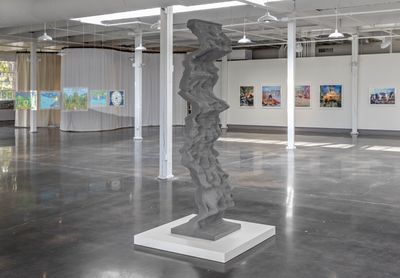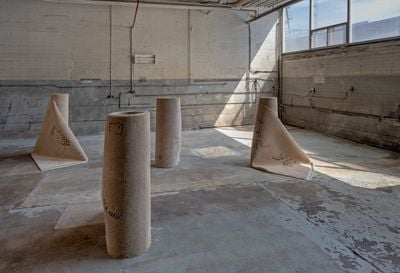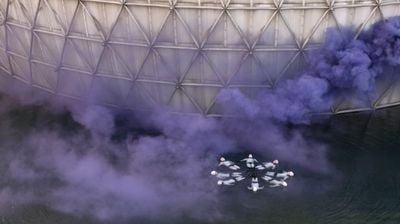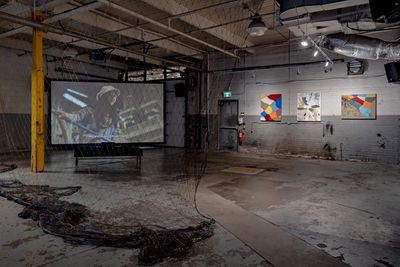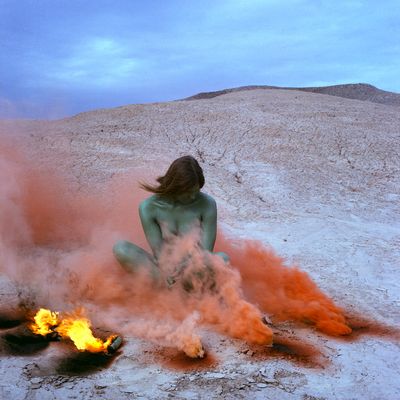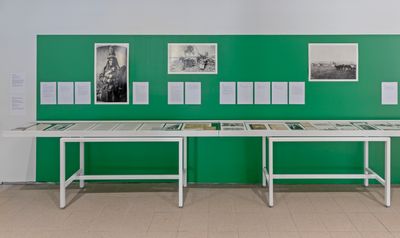First Toronto Biennial Digs Deep

Adrian Stimson, Iini Sookumapii: Guess who's coming to dinner? (2019). Mixed-media installation. Dimensions variable. Commissioned by the Toronto Biennial of Art. Exhibition view: The Shoreline Dilemma, Toronto Biennial of Art, 259 Lake Shore Boulevard East, Toronto (21 September–1 December 2019). Courtesy Toronto Biennial of Art. Photo: Toni Hafkenscheid.
The first Toronto Biennial of Art, The Shoreline Dilemma (21 September–1 December 2019), could have easily laid claim to the city's 'rising international status as a destination for arts and culture' as the reason for its existence, and staged a global exhibition within this context. But Canadian curators Candice Hopkins and Tairone Bastien chose to dig down instead, unearthing and uncovering Toronto's sediment layers and turning their attention to the radical reshaping of Toronto's waterfront. In the process, the exhibition calls 'into question the rights of land and water in light of accelerated development' and asks what it means 'to be in relation'.
Toronto's shoreline is used to link more than 15 indoor and outdoor venues, as well as exhibition partner sites, all playing host to more than 100 artworks, including over 20 commissions by 90 participants who come from 40 places of origin. There are two main locations: a former home to Volvo and other tenants since 1923 at 259 Lake Shore Boulevard East and the Small Arms Inspection Building, a remodelled 1940 military facility in Mississauga, Toronto's neighbouring city.
The Biennial is forthright in acknowledging the land on which it unfolds: on the traditional territory of the Huron-Wendat, Haudenosaunee, and Anishinaabe peoples, including the Mississaugas of the Credit First Nation. This acknowledgement registers a more nuanced understanding of site, situation, and context for the art on view. For example, Algonquin-French artist Caroline Monnet's The Flow Between Hard Places (2019), a large freestanding undulating form that concretises the sound of the word 'pasapkedjinawong' (the river that passes between the rocks) in Anishinaabemowin.
Throughout, artworks highlight what is contained within the land or what is hidden about it. At the Small Arms Inspection Building, Untitled (MAP) (2016) by Montreal-based Hajra Waheed, whose solo exhibition Hold Everything Dear is on view at The Power Plant, tracks the ebbs and flows of the world's largest offshore oil field near the artist's childhood home in Saudi Arabia. Presented in the form of an elongated print with intermittent folds, its placement atop a long rectangular plinth evokes mountainous terrain, even as it represents a site of geopolitical contention.
Toronto-born, New York-based artist Moyra Davey's black and white C-prints in Gold Dumps and Ant Hills (1992/2019) also play with scale, depicting images of natural and unnatural digging in the form of small anthills and mounds of earth—the remnants of gold mining activities, which represents the largest trade in Johannesburg.
Peruvian-born, Toronto-based artist Luis Jacob insists on matters of record in The View from Here (2019), his installation in the historic Oak Room at Union Station incorporates the architectural heritage of the city's main transit hub beginning in 1858 to its current Beaux-Arts building opening in 1927. Taking maps that archive Toronto's development through its planning history, Jacob juxtaposes these with large C-prints detailing many of these same sites today. Installed within a wood frame mimicking construction sites complete with concrete blocks, the cartographic imaginary is held to account in terms of the reality of these developments as some images attest to their disintegration over time.
For Jacob's other presentation at 259 Lake Shore Boulevard East, a long vitrine houses The View from Here (Library) (2019)—the artist's personal collection of publications about Toronto. Including exhibition catalogues, published materials on Toronto's urban development, immigrant populations, counter-cultures and more, closer inspection reveals how every cover is printed in English, prompting the question of how dominant languages might affect personal or collective narratives among those for whom a lingua franca is not their native tongue.
Istanbul artist Hera Büyüktaşçiyan's award-winning installation Reveries of an Underground Forest (2019) expands on the conundrum of language when it comes to understanding place. Within a large area of the Lake Shore building, partially rolled carpets are standing up or unfolded on the floor creating a desert- or dune-like environment. Signs and symbols are mapped onto each carpet to create an alternate legend marking other paths of knowledge and experience.
Like Büyüktaşçiyan, the New Mineral Collective—a 'company' based in Norway that focuses on 'counter-prospecting operations and geo-trauma healing'—reveals the inherent language of landscape, translating this into physical, experiential and time-based forms that set the scene for human interaction. At the Small Arms Inspection Building, Pleasure Prospects (2019) consists of cast boreholes made of layers of compressed zinc, copper, steel, and other materials, appear to have risen from below ground and placed on mirrored bases like a truncated forest.
The manipulation of architectural space occurs in various projects as a means to reposition social dynamics and the politics of place. Toronto artist Adrian Blackwell's Isonomia in Toronto? (2019) invites participation in weekly programmes utilising seating structures created for both main Biennial locations. Isonomia in Toronto? (creek) (2019), a 300-foot-long tubular cushion is printed with a reproduction detailing the boundary between water and land outside of the Small Arms Inspection Building, serving as the natural dividing line between Mississauga and Toronto as neighbouring cities.
At 259 Lake Shore Boulevard East, Isonomia in Toronto? (harbour), Blackwell's other large multi-tiered wooden seating construction complete with ramp access, also invites a crowd by providing cushion seating. Both serve as spaces for communal gatherings while engaging in social and pedagogical discourse.
Tapping into the potency of community bodies is Sioux artist Dana Claxton's 'Headdress' series (2018–2019)—'firebox' portraits of indigenous women dripping in a spectacular mix of beadwork, feathers, and other accessories, which do not obscure as much as punctuate the individuality of their owners. Cleveland's Jae Jarrell's clothing partly decorates and partly protects. One of her designs placed next to Claxton's work is Ornaments of Reflection (2019), a black dress covered with a red shoulder cape pierced with dangling beaded threads—all in leather. Jarrell's solo presentation at Art Gallery of York University highlights Revolutionary Suit (1969), detailing a life melding fashion, art, and political organisation, such as through co-founding AfriCOBRA (African Commune of Bad Relevant Artists) in 1968.
The spirit of self-authored identities can also be found at the Small Arms Inspection Building, where the Isuma artist collective presents One Day in the Life of Noah Piugattuk (2019), their film on a single day of the Piugattuk family who are asked their leave their land, following its showing at the Canadian Pavilion for the 58th Venice Biennale. A solo presentation of their work is also on view at the Art Museum at the University of Toronto.
Elsewhere, the body merges with otherworldly realms. Shezad Dawood's film cycle Leviathan (2017) is presented as an installation for the Biennial and within a solo presentation at the Museum of Contemporary Art, intermixing technological, cosmological, pseudo-scientific, eco-conscious, and virtual realities. Melding the body with the land is Judy Chicago, whose colour video Women and Smoke (1971–1972) and accompanying photographs are based on 'Atmospheres', a series of performances begun in the 1960s that align the body to its surrounding landscape and counteract male-oriented and dominated land art.
The domination of land also hits close to home for Vancouver-born, Berlin-based AA Bronson, who conducted, as part of the Biennial's performance programme, his A Public Apology to Siksika Nation (2019) to Siksika artist Adrian Stimson as well as other residential school survivor representatives. The ceremonial act of remembering lingering ancestral pain and its subsequent generational consequences came from Bronson acknowledging his great-grandfather Reverend John William Tim's role as the first Anglican missionary fighting against Stimson's own relative, Siksika Nation Chief Old Sun. Further recorded through an installation including documentation and a publication at the Lake Shore building, the question remains: in the call to forgive can one truly forget?
Sound plays an effective role in making audible potentially inarticulate moments, not to mention bridging the gap between history and the present, and possible futures. Vancouver- and Montreal-based Althea Thauberger and Kite collaborated on the audio and video installation Call to Arms that coincides with their performance Battle Cry (Gift to the Shell Ensemble) both created in 2019. Featuring the musical talents of Her Majesty's Canadian Ship (HMCS) York Band, the conch shell sextet performs on-screen but also a live rendition in their military drill hall, walking among the audience who are loosely seated in a circular, shell-like formation.
Dawn Chorus / Evensong (2019) by Lou Sheppard, born in unceded Mi'kmaq territory and now based in K'jipuktuk, Halifax, offers another possibility to look and listen: a sonic forest at the Toronto Sculpture Garden, while the Harbour Symphony employs boats along Toronto's Harbourfront Centre to play for unsuspecting passers-by.
Having reached deep into the ground to trace and reinvigorate long dried riverbeds while remapping a different trajectory for the future within the loom of the Anthropocene, a strong undercurrent remains in this show. What does it mean to have a Biennial named after a city for those who have rooted their practices in that same region over many years? As a long-time former Torontonian, the Toronto Biennial of Art hearkens back to when the city was still en route to situating itself within an international art context—the latest and largest checkmark signalling a continuation in this direction. Though the same curators are scheduled to organise the next Biennial, the question of what comes next still remains. —[O]


